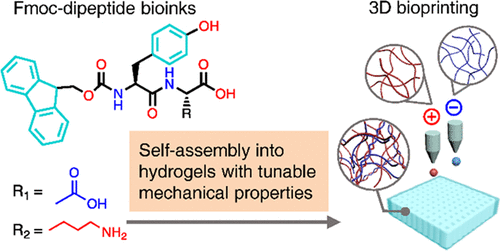当前位置:
X-MOL 学术
›
ACS Appl. Mater. Interfaces
›
论文详情
Our official English website, www.x-mol.net, welcomes your
feedback! (Note: you will need to create a separate account there.)
Dipeptide Self-Assembled Hydrogels with Tunable Mechanical Properties and Degradability for 3D Bioprinting.
ACS Applied Materials & Interfaces ( IF 8.3 ) Pub Date : 2019-12-06 , DOI: 10.1021/acsami.9b13905 Honglei Jian 1 , Meiyue Wang 1 , Qianqian Dong 1 , Jieling Li 1 , Anhe Wang 1 , Xin Li 1 , Peng Ren 1 , Shuo Bai 1, 2
ACS Applied Materials & Interfaces ( IF 8.3 ) Pub Date : 2019-12-06 , DOI: 10.1021/acsami.9b13905 Honglei Jian 1 , Meiyue Wang 1 , Qianqian Dong 1 , Jieling Li 1 , Anhe Wang 1 , Xin Li 1 , Peng Ren 1 , Shuo Bai 1, 2
Affiliation

|
Supramolecular hydrogels self-assembled from short peptides have shown great potential as biomimetic extracellular matrices with controllable properties designed at the molecular level. However, their weak mechanical strength still remains a big challenge for 3D bioprinting. Herein, two oppositely charged dipeptides are designed and used as bioinks in a ″layer-by-layer″ alternative bioprinting strategy. During printing, in situ gelation is achieved by electrostatic interactions between two dipeptides without additional cross-linking procedures. The binary hydrogels have tunable mechanical properties with elastic moduli ranging from 4 to 62 kPa and controllable biodegradability from days to weeks, which can ideally mimic the natural environment of a variety of cell types. It is demonstrated that the hydrogel scaffold enables the formation, growth, and natural release of HepaRG spheroids with sizes up to millimeters. This strategy may be suitable to develop a series of new bioink materials based on peptides and other supramolecular polymers for 3D bioprinting.
中文翻译:

具有可调整的机械性能和可降解性的二肽自组装水凝胶,可用于3D生物打印。
由短肽自组装的超分子水凝胶作为具有仿生性的细胞外基质,具有在分子水平设计的可控特性,具有巨大的潜力。但是,它们较弱的机械强度仍然是3D生物打印的一大挑战。本文中,设计了两个带相反电荷的二肽并将其用作“逐层”替代生物打印策略中的生物墨水。在印刷过程中,两个二肽之间的静电相互作用可实现原位凝胶化,而无需其他交联程序。二元水凝胶具有可调的机械性能,弹性模量范围为4至62 kPa,可控制的生物降解能力从几天到几周不等,可以理想地模拟多种细胞类型的自然环境。已经证明水凝胶支架能够形成,生长,并自然释放尺寸最大为毫米的HepaRG椭球。该策略可能适合于开发一系列基于肽和其他超分子聚合物的新型生物墨水材料,以进行3D生物打印。
更新日期:2019-12-07
中文翻译:

具有可调整的机械性能和可降解性的二肽自组装水凝胶,可用于3D生物打印。
由短肽自组装的超分子水凝胶作为具有仿生性的细胞外基质,具有在分子水平设计的可控特性,具有巨大的潜力。但是,它们较弱的机械强度仍然是3D生物打印的一大挑战。本文中,设计了两个带相反电荷的二肽并将其用作“逐层”替代生物打印策略中的生物墨水。在印刷过程中,两个二肽之间的静电相互作用可实现原位凝胶化,而无需其他交联程序。二元水凝胶具有可调的机械性能,弹性模量范围为4至62 kPa,可控制的生物降解能力从几天到几周不等,可以理想地模拟多种细胞类型的自然环境。已经证明水凝胶支架能够形成,生长,并自然释放尺寸最大为毫米的HepaRG椭球。该策略可能适合于开发一系列基于肽和其他超分子聚合物的新型生物墨水材料,以进行3D生物打印。






























 京公网安备 11010802027423号
京公网安备 11010802027423号